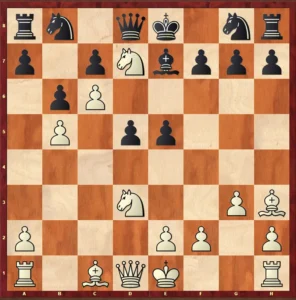To write or understand chess notation, you must first know the name of each square on the chess board. The name of each square on the chess board can be figured out so there is no need to memorize it.

Check out this chessboard. Here the green line is called “a” file. Similarly, b, c, d, e, f, g, and h are all one file. Again the red line means a 1st rank. Similarly, there are 2nd, 3rd, 4th, 5th, 6th, 7th, and 8th ranks on the chess board. With this file and rank, we can easily find the name in any square. The formula of square name is (file name + rank name = square name). That is, if you want to find out the name of a square, first you have to see which file that square is located in, and then you have to see which rank that square is located in.
Square Name:

Here the green square is on the c-file and the 4th rank so the green square name is c4. And the red square is on the e-file and the 5th rank so the red square name is e5.
To write the complete notation we need to add the symbol of the name of the chess piece we moved before the name of the square.
Example 1:

Here the knight has moved to f file and 3rd rank. Knight’s symbol is N. So here the notation should be written as Nf3. Piece symbols will always be capital letters and square names will always be small letters.
Example 2:

Here the black d file’s pawn moves to 5th rank. To avoid using any symbol of pawn here only the name of the square will be used. So this move would be d5.
Capturing Notation
Capture by Piece:

When capturing something then use x for capturing.
Here the knight on the f3 square is going to capture the black pawn on the e5 square. After capture the notation here will be Nxe5.
Capture by Pawn:

Since no pawn symbol is used, capturing with the pawn is just (file x square name).
Here the pawn of d5 is being captured with the pawn of e file. So the notation here would be exd5.
Capture by same rank’s piece

If an opponent’s piece or pawn is captured by a piece in the same rank or file as ours, then we must indicate which file or rank piece it was captured by.
Example:
Here d3 and f3 both knights can capture black’s e5 pawn. So here you have to indicate which knight has the pawn. If captured by d3’s knight the notation would be Nde5. If captured by f3’s knight the notation would be Nfd5.
Capture by same file’s piece

Here d7 and d3 both white knights are on the same file and both can capture Black’s pawn on e5. So if d7 is captured by the knight the notation would be N7e5 (ie the e5 pawn is captured by the 7th-rank knight). And if the knight of d3 square is captured then the notation will be N3e5 (i.e. the pawn of e5 is captured by the knight of 3rd rank)
Castling Notations:
King’s side or Sort side Castling notation is O-O
Queen’s side or Long side Castling notation is O-O-O
Pawn Promotion Notation:
g8(Q) or g8=Q
In other words, the pawn has been promoted to the queen on the g8 square.
Chess Annotation Symbols
| Symbol | Meaning |
| # | Checkmate |
| + | Check |
| ++ | Double-check |
| ! | Good Move |
| !! | Excellent Move |
| ? | Bad Move |
| ?? | Blunder Move |
| !? | Interesting move |
| ?! | Dubious move |
| = | Equal position |
| ⩲ | The white position is slightly better. |
| ⩱ | The black position is slightly better. |
| ± | Clear better for the White position |
| ∓ | Clear better for the Black position |
| ∞ | Unclear position |
| ↑ | Initiative |
| → | Attack |
| ⇄ | Counterplay |
| ↻ or ↑↑ | Development |
| ⊕ | Time trouble, Time is very low. |
| ⊙ | Zugzwang |


